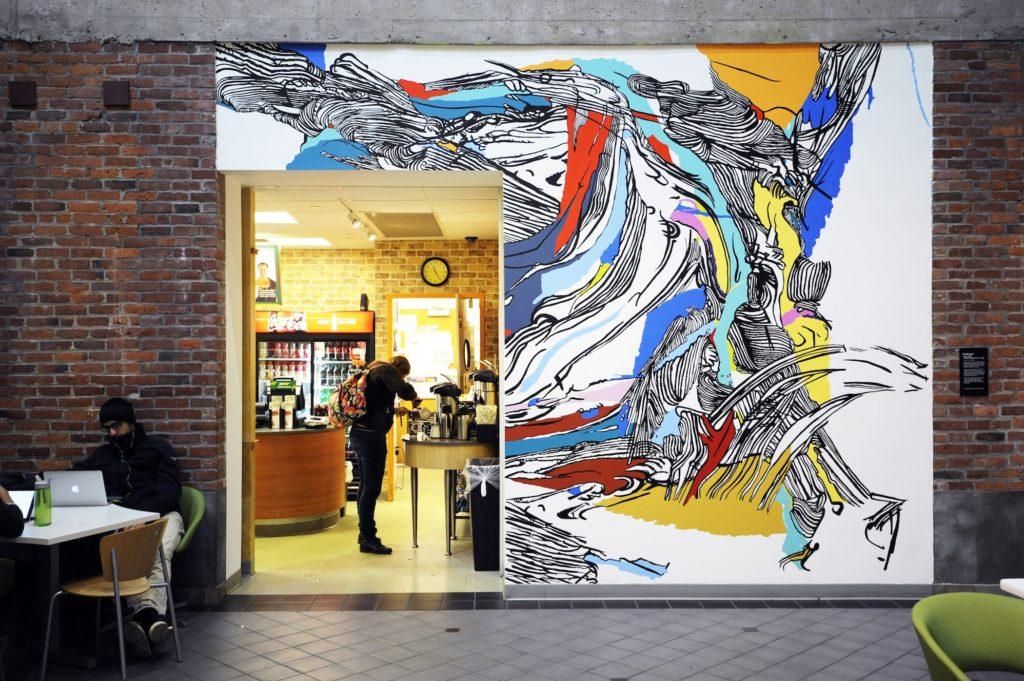By Rebecca Sirull, Inside Editor
Visitors to Ryder Hall over the past few weeks were treated to a new view as the latest installation of Northeastern’s public art initiative brightened the wall. Art professor Sophia Ainslie created the mural “In Person” with the help of four students and her intern as a way of engaging with a wider audience.
The piece is part of a series that Ainslie has been working on since 2009 in the wake of her mother’s death. Ainslie explained that the painting, which combines an assortment of brightly colored shapes with strong black lines, represents the intersection of body and landscape. She was originally inspired by X-rays of her mother’s abdomen during her battle with cancer, which she said translated into the bold shapes of the painting.
“When I was looking at the X-ray, I was really amazed at how the inside of the body related so much to drawing,” Ainslie said. “There was this fragility to the X-ray and also the line work and interesting shapes.”
She then combined this image with the black markings she saw in territorial maps and the landscapes of the environment around her.
“I brought those two languages together in this work,” Ainslie said.“The colored shapes are all directly from the X-ray, so those are my mother’s body. And then the black marking is all from my translation of landscape.”
The piece gets another layer of meaning with the insertion of white spaces, which Ainslie explained as the representation of absence.
“It’s her body and it’s my landscape and then the white is the sense of absence, so it’s her not being here anymore and how present absence is in all our lives,” she said. “We all live with a sense of memory of something that’s passed, and I think it’s trying to make that which is gone have a presence.”
The students who assisted Ainslie agree that in addition to its deeper meaning, the painting also adds a beauty to the area that piques the interest of passersby. One of Ainslie’s assistants, third-year graphic design major Jill Rosenberg, thought that the intricacies of the painting left it up to the viewer’s interpretation. Rosenberg has worked with Ainslie in the past on a number of different projects, including other variations of the body-landscape piece. She found it interesting how, although the premise for the paintings was all the same, each work turned out with its own variations that made it distinct from the others.
“I think that you can look at this and see something different every time, and I think that’s what art’s about – grabbing people’s attention – and I’d like to think that this does that,” Rosenberg said.
Heather Jensen, a third-year communication studies major, echoed this sentiment about public art in general.
“It makes you appreciate art more because you recognize how it interacts with the space and how it makes you feel,” Jensen said.
Above all, the artists hope to create something that evokes a reaction from the audience and causes them to stop and think.
“I hope that it make people slow down and take a look at it and appreciate it and become aware of their surroundings rather than having that mindset of getting to class and rushing everywhere,” Rebecca Porter, a sophomore graphic design major, said.
For Ainslie, the goal of the piece, and of her large-scale art in general, is a bit broader. She hopes to create a connection with her audience, to not only make them stop and look around, but also to critically examine their own emotions and ideas.
“What I hope to get from the audience is a sense of engagement and a sense of curiosity,” Ainslie said. “I think it’s also about some kind of reaction – it doesn’t matter if it’s a good reaction or a bad reaction – just any reaction is what I’m after. In a sense, it’s about a dialogue with the audience… It’s not about me imposing an idea onto the audience. It’s more about engagement.”
Photo courtesy Matthew Modoono, Northeastern University















